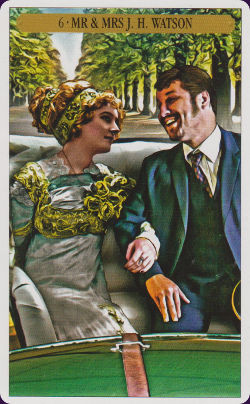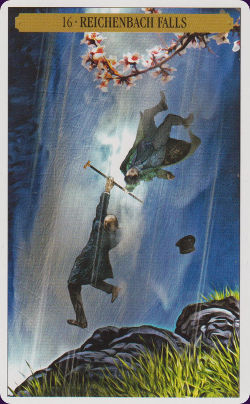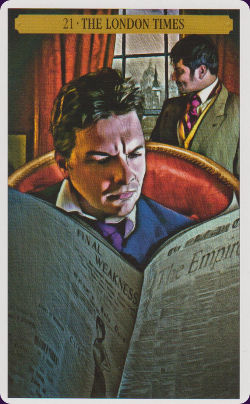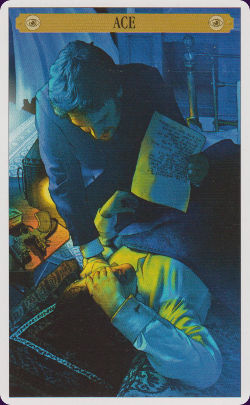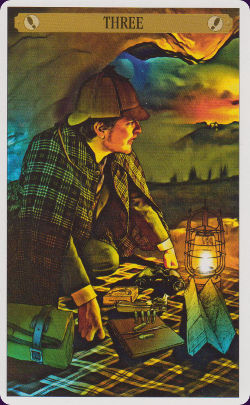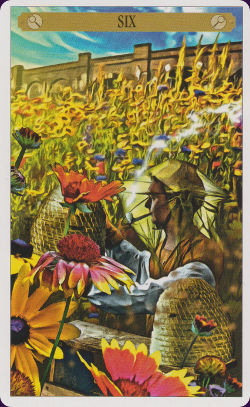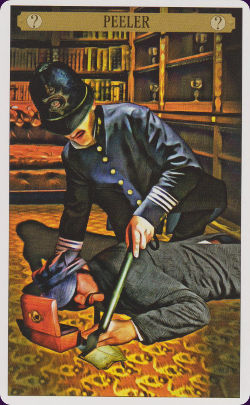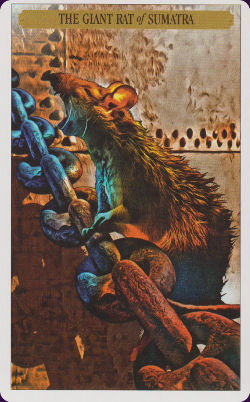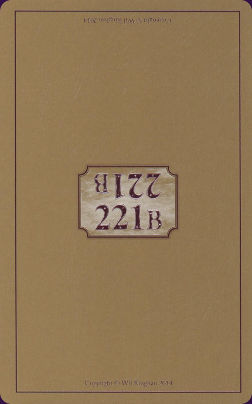Sherlock Holmes Tarot Deck Review
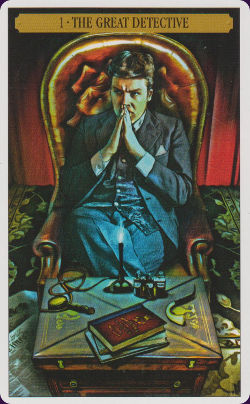
The legendary literary detective comes alive in the Sherlock Holmes Tarot. This beautifully themed 79-card deck stays true to the characters, era and stories from the books by Arthur Conan Doyle. The majors are important figures and locations from the books, while the minors each have a scene from a particular story.
Deck Type: Tarot Deck Cards: 79
Creators: John Matthews, Wil Kinghan
Publisher: Connections 2014
Retailers
See Price at Amazon.comSee Price at Amazon.co.uk
See Price at Amazon.ca
Sherlock Holmes Tarot Review by Danusha V. Goska
I am not a "Sherlockian." As a kid, I watched the Basil Rathbone / Nigel Bruce movies on TV, and also the 1971 film "They Might be Giants," which I adore. I've read two Sherlock Holmes stories, which I liked, but not well enough to want to read more. I am not a fan of the Victorian Era. So, I can't offer a cognoscente's review. If the deck contains some violation of the Holmes universe or Victoriana, it slipped right past me, and given that I'm not religious about Holmes or the Victorian Era, I don't care. I am a fan of tarot and I can say that this is a respectable tarot deck.
Wil Kinghan's images are aesthetically pleasing and unusual. His technique is ink line work and digital painting, with photographs of friends used as models.
This technique results in images that are reminiscent of antique black-and-white photographs that have been hand-tinted with color.
Kinghan's set pieces - one might almost call them dioramas - are faithful to the Victorian Era. There are high collars, high hats, cobblestones, and distant, domed roofs seen out of coal-dimmed windowpanes. But there are also some shockingly vivid colors: reds, purples, and chrome yellow, pulsing vividly. As is appropriate for a deck inspired by a criminal investigator, living in London, from the era before electricity, most cards depict dusk or night crossed with wisps of fog. Between the bright colors and the stygian atmosphere, this deck depicts a collision between neon and gaslight.
Kinghan's cards are so busy with life, they jump off the page. The Magician is Sherlock Holmes himself. He is sitting, thinking - but Kinghan infuses electric life into this seated thinker. He's about to jump up with a great insight and solve a case. The minor arcana are drawn with all the color, dynamism, and detail as the major arcana.
The four of evidence - analogous to the four of wands - depicts Holmes and Watson celebrating at a pub. The scene is alive: there are chandeliers, booths with other customers, candles, bottles, curtains, and a waiter. The line of the table comes at the viewer like a Dutch angle.
Other scenes are more dynamic still. The eight of evidence (eight of wands) depicts a train, puffing smoke, hurtling into the distance over a bridge, moon overhead. Holmes, in a tall hat, is just glimpsed peeking out one of the windows. It's hard to look at this card without entering into the scene, and imaging a story to accompany the image.
The five of deduction (five of coins) depicts a woman's deathbed. That could have been a static scene. In Kinghan's hands, it is alive - no anti-pun intended. There are dramatic shadows, and Holmes assumes a posture tense with meaning as he is dragged by a beagle. The lightning-like gleam from a top hat highlights Kinghan's attention to detail.
The Sherlock Holmes Tarot is one deck for which the user will very much want, and will make extensive use of, the accompanying book.
Matthews has a New York Times bestseller to his credit; he can write. Two beauties of his text are its specificity and that it does not over promise. This isn't fluffy New Age stuff about how if you focus your intention you will win the lottery. It's about more grounded, detailed, day to day stuff, with Holmes as your guide. Each card is accompanied by a quote from a Holmes story.
Matthews' interpretations of reversed cards are every bit as extensive as his comments for upright cards. Upright interpretations are called "the game," as in "The game is afoot." Reversed interpretations are dubbed "the fog," that obscuring meteorological phenomenon we associate with London.
Matthews reconfigures the minor arcana as observation (swords), evidence (wands), analysis (cups) and deduction (pentacles). The pages are Baker Street Irregulars, that is the street urchins whom Holmes employed. Pages are all too often throwaways; here they are especially good. Knights are peelers, a slang word for police officer like the more familiar "bobby." Queens are ladies, and kings are inspectors. Both major arcana and minor arcana are depicted using characters and events from the Holmes canon.
The meanings of the cards are made very clear in the book. For example, the five of pentacles depicting a woman's deathbed is explained as an event from a Holmes story that fits quite neatly with the traditional interpretation of the card. For me as a reader, this deck would have been more valuable if these meanings were made easier and quicker to grasp. I fear that I may be struggling with working out equivalences: "eyeball on card means the card is part of the observation suit and observation means swords." Since I am not a Sherlockian, I don't know all the plots the cards depict, and I would have liked reminders on the cards themselves: a small sword at the bottom of the card, for example, plus a discrete, one-word prompt like "regret" for the five of analysis (five of cups).
Second, we all know Sherlock Holmes had a problem with women, and, by extension, all that the cups suit represents. Rather than create a cups suit and have Holmes react to it, the cups suit is processed through Holmes; it is the cups suit through Holmes' limited and hyper-rational point of view. To me that's a mistake. Holmes may have been a great (if fictional) man, but he wasn't able to eliminate emotions, spirituality, the feminine, or the supernatural. Heck, I hear there is even a new tarot deck named after him. I wish the cups suit had been more traditional, and firmly, representative of that very side of life that Holmes found so challenging.
I love detailed, rich, intelligent tarot decks that, like a novel, create their own world. I am delighted by intriguingly new but integral and faithful interpretations of tarot's timeless themes. I value fine artwork that pleases my eyes. I am grateful when I can find a deck that is accompanied by a book that is well-written. The Sherlock Holmes Tarot offers all these gifts.
Sherlock Holmes Tarot Review by Bonnie Cehovet
“I never guess. It is a shocking habit –
destructive to the logical faculty.”
~ The Sign of Four
I have had my eye on this deck, and finally decided that I “had” to have it! I am very pleased with both the artistry and the presentation of the cards. The story of Holmes, Watson, and 221B Baker Street is as I hold it in my mind. If it wasn’t, the deck would have been gifted on. Why keep something that is very important in your life if it doesn’t fit the image that you have of it?
This is a 79 card deck, along traditional lines, with cards retitled to fit the theme of Sherlock Holmes. (Examples include Inspector Lestrade as the Fool (I had to think about that one), The Great Detective as the Magician, and Irene Adler as the High Priestess.) The extra card is listed as a Wild Card (represented by the Giant Rat of Sumatra). The suits are Observation (Swords), with an eye as an icon; Evidence (Wands), with a foot as an icon; Analysis (Cups), with a magnifying glass as an icon; and Deduction (Pentacles), with a question mark as an icon. The Court cards are Baker Street Irregular (Page), Peeler (Knight), Lady (Queen), and Inspector (King).
The deck and 160 page companion book come in a sturdy cardboard box with a lift-off top. The cover shows Holmes and Watson, while the back of the box gives information about the deck.
In their preface, Mathews and Kingham talk about this deck as reflecting the “inner landscape” of Sherlock Holmes. Indeed it does! I dearly love Sherlock Holmes (in my mind as portrayed by Basil Rathbone, with Nigel Bruce as Dr. Watson). In Part One: The Wisdom of Holmes & Watson, we read about Arthur Conan Doyle, the man who imagined Sherlock Holmes and his deductive abilities. The stories were popular from the very beginning, which is understandable. I have read them all over and over and over again! It was also interesting to read about real individuals that may have been used as prototypes in building the character of Holmes. The authors pose the question of whether Holmes himself would have approved of the Tarot, and come up with some interesting conclusions! In this deck we see the wisdom of Sherlock Holmes applied through the Tarot – IMHO to great advantage!
In Part Two: The Greater Mystery – The cards and their meanings, the game is literally afoot! This section starts out with a listing of renamed titles for the Major Arcana, the retitled suits and Court cards, and the icons that represent each suit. Each card is represented by a black and white image, The Game (a summary of the meaning of the card), The Fog (reversed meanings), Keys (shorter meanings), and Holmesian Wisdom (quotes from the Sherlock Holmes canon). Note: I love that the Holmesian Wisdom quotes are presented within the circle of a magnifying glass!
In Part Three: The Art of Investigation – working with the cards, the authors talk about what each of the suits does, and using the Wild Card. Spreads include the four card Lens Spread, the eight card Great Detective Spread, and the nine card Enquiry Spread. Several pages are left blank at the end of the book for notes and observations.
The Major Arcana depict figures and locations from the Sherlock Holmes stories, while the Minor Arcana depict scenes from specific stories. (It was a joy to go through this deck for the first time, and recognize so many people and scenes!) I was also impressed with the representation of the Victorian era, of which I am a huge fan.
The artwork brought the theme together in a wonderful fashion – one could believe they were in the Victoria era, even if only for a short while. The high hats, candles, and gas lamps, along with foggy streets, tell the story. Tarot aficionados will be happy to note that Caitlin Matthews graciously agreed to pose for some of the cards in this deck!
The cards are 2 7/8” by 4 7/8”. The backs are gold, with 221B back to back in the middle of the card. (We all know who lived at 221B Baker Street!) The card faces show a ¼” white border, surrounding the card image. The card number and title is across the top of the card, in black lettering against a gold background. The Minor Arcana show the card number or title, but not the suit. Suits are indicated by icons placed in the upper right and left hand corners of the card.
I am still not used to Inspector Lestrade as the Fool … but I am getting there. Here we see Lestrade, in a brown overcoat and hat, facing away from us. He looks to be on the docks, gun in his right hand, lantern in his left hand. Holmesian Wisdom is “I take a shortcut when I can get it.”
The Great Detective shows Holmes sitting in a chair, facing the reader, his hands in a “V” in front of him, his legs crossed. On the table in front of him is a lit candle, books, and other items of detection. He appears pensive, as only Sherlock Holmes can appear. Holmesian Wisdom is “A conjurer gets no credit once he explains his trick.”
Irene Adler shows a young woman seated, in what appears to be a restaurant or tea shop. She is dressed for public with a hat, and is seated next to a table with a teapot and teacup. In the background we see both men and women standing. The Holmesian Wisdom is “Woman are naturally secretive, and they like to do their own secreting.”
The Three of Observation (Swords) features Holmes in a fit of depression, standing at the window looking out at the London fog, newspapers in front of him. The Holmesian Wisdom is “The most difficult crime to track is the one that is purposeless.”
The Baker Street Irregular of Observation (Page of Swords) shows an envelope coming in through the mail slot in a door. The slot is open, and we see a pair of eyes looking through it. The Holmesian Wisdom is “They can go everywhere, see everything, overhear everyone.”
The Five of Evidence (Wands) shows a candlelit room, with Holmes standing in the background, in a dark overcoat and hat. Holmes is seen subduing a red headed man. The Holmesian Wisdom is “I know my dear Watson that you share my love of all that is bizarre.”
The Ace of Analysis (Cups) shows Holmes sitting in the middle of a candlelit room, wearing an overcoat and hat, and smoking his pipe. Papers are strewn all around him. The Holmesian Wisdom is “I can only see two things for certain. It’s the chain between them we are going to have to trace.”
The Lady of Deduction (Queen of Pentacles) shows Mrs. Hudson standing in front of a red door, holding a tea tray. The Holmsian Wisdom is “I do not encourage visitors.”
The Peeler of Deduction (Knight of Pentacles) shows a constable, crouched over a body in a library. Next to the body we see a fallen notebook, and a small wooden box that has broken open. The Holmesian Wisdom is “Each fact is suggestive in itself. Together they have a cumulative force.”
This is not a learning deck – but it is a deck that would be thoroughly enjoyed by someone that likes themed decks, and/or someone that loves Sherlockian lore.
Complete Details of Sherlock Holmes Tarot
Creators: John Matthews, Wil KinghanPublisher: Connections 2014
Deck Type: Tarot Deck
Cards: 79
Major Arcana: 22
Minor Arcana: 56
Minor Arcana Style: Unique Scenes Without Suit Symbols
Suits: Observation (Swords), Evidence (Wands), Analysis (Cups), Deduction (Pentacles)
Court Cards: Baker Street Irregular (Page), Peeler (Knight), Lady (Queen), Inspector (King)
Major Titles: 0 - Inspector Lestrade, 1 - The Great Detective, 2 - Irene Adler, 3 - The Queen-Empress, 4 - The Prince-Consort, 5 - The Seven-Per-Cent Solution, 6 - Mr and Mrs J.H. Watson, 7 - The Hansom Cab, 8- Dr John H. Watson, 9 - Mycroft Holmes, 10 - Bradshaw's Directory, 11 - The Courts of Justice, 12 - The Crooked Man, 13 - The Gallows, 14 - Mrs Hudson, 15 - Professor Moriarty, 16 - Reichenbach Falls, 17 - The Blue Carbuncle, 18 - The Hound of the Baskervilles, 19 - The Magnifying Lens, 20 - The Final Problem, 21 - The London Times
Card Size: 2.95 x 4.72 in. = 7.50cm x 12.00cm
Card Language: English
Card Back: Reversible
Back Design: Plain golden backs with '221b' mirrored in a central plaque.
Companion Material: A 160-page companion book by John Matthews and Wil Kinghan is packaged with the cards.
Extra Info: The 79th card is a wild card similar to the Happy Squirrel, titled 'The Giant Rat of Sumatra'.
Rating: 18/20 or
Similar Decks to Sherlock Holmes Tarot
Theme: Books & Literature, Victorian EraCategory: Tarot Decks with a Happy Squirrel Card
Creator: Cathar Tarot, Celtic Wisdom Oracle, Lost Tarot of Nostradamus, Shaman's Oracle, Steampunk Tarot by Wil Kinghan Arthurian Tarot, Byzantine Tarot, Camelot Oracle, Cathar Tarot, Celtic Oracle, Celtic Shaman's Pack, Grail Tarot, Lost Tarot of Nostradamus, Shaman's Oracle, Steampunk Tarot, Wildwood Tarot by John Matthews
< Previous Deck · Back to Top · Next Deck >
Home > Tarot Reviews > Sherlock Holmes Tarot Review

